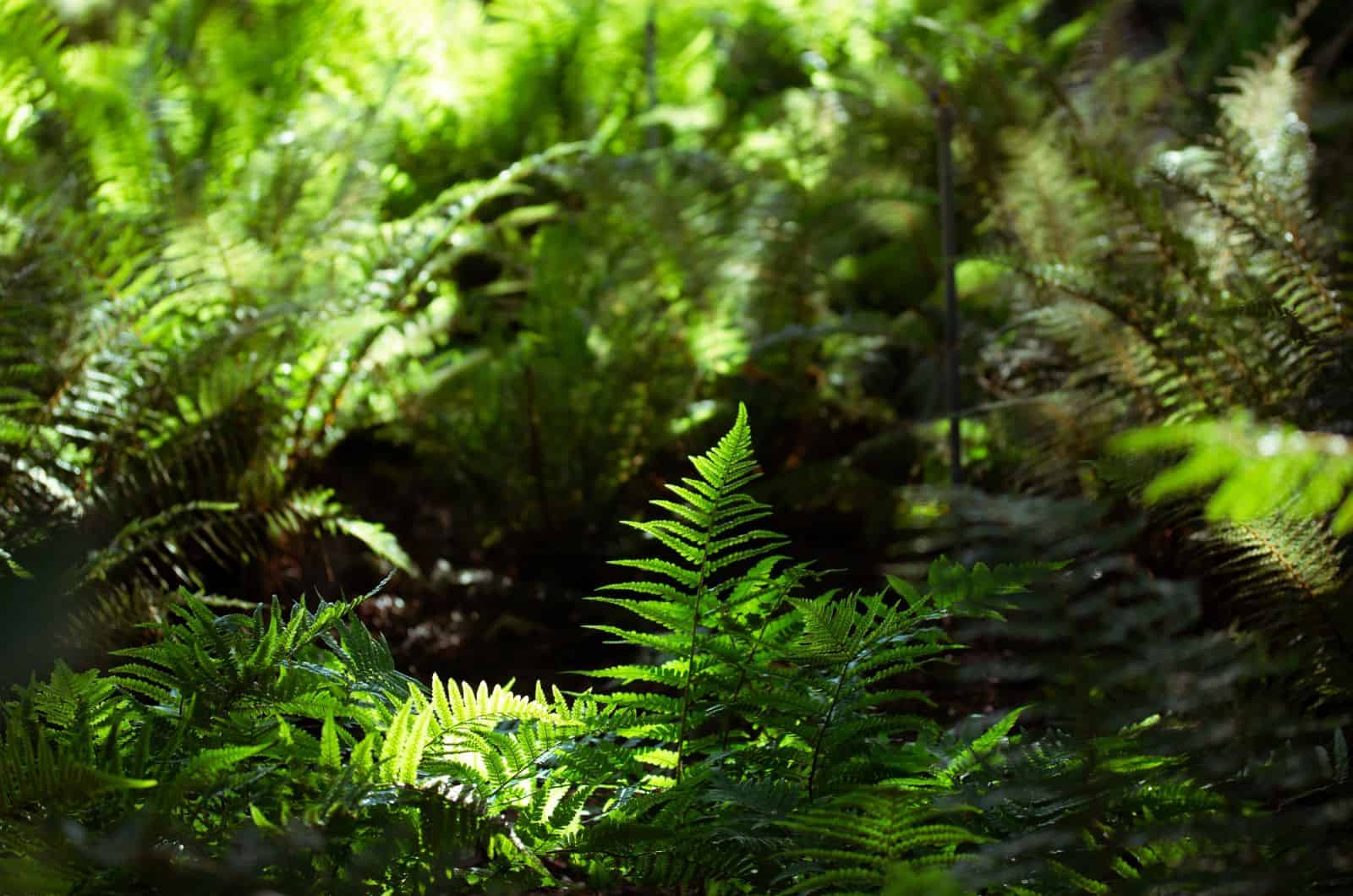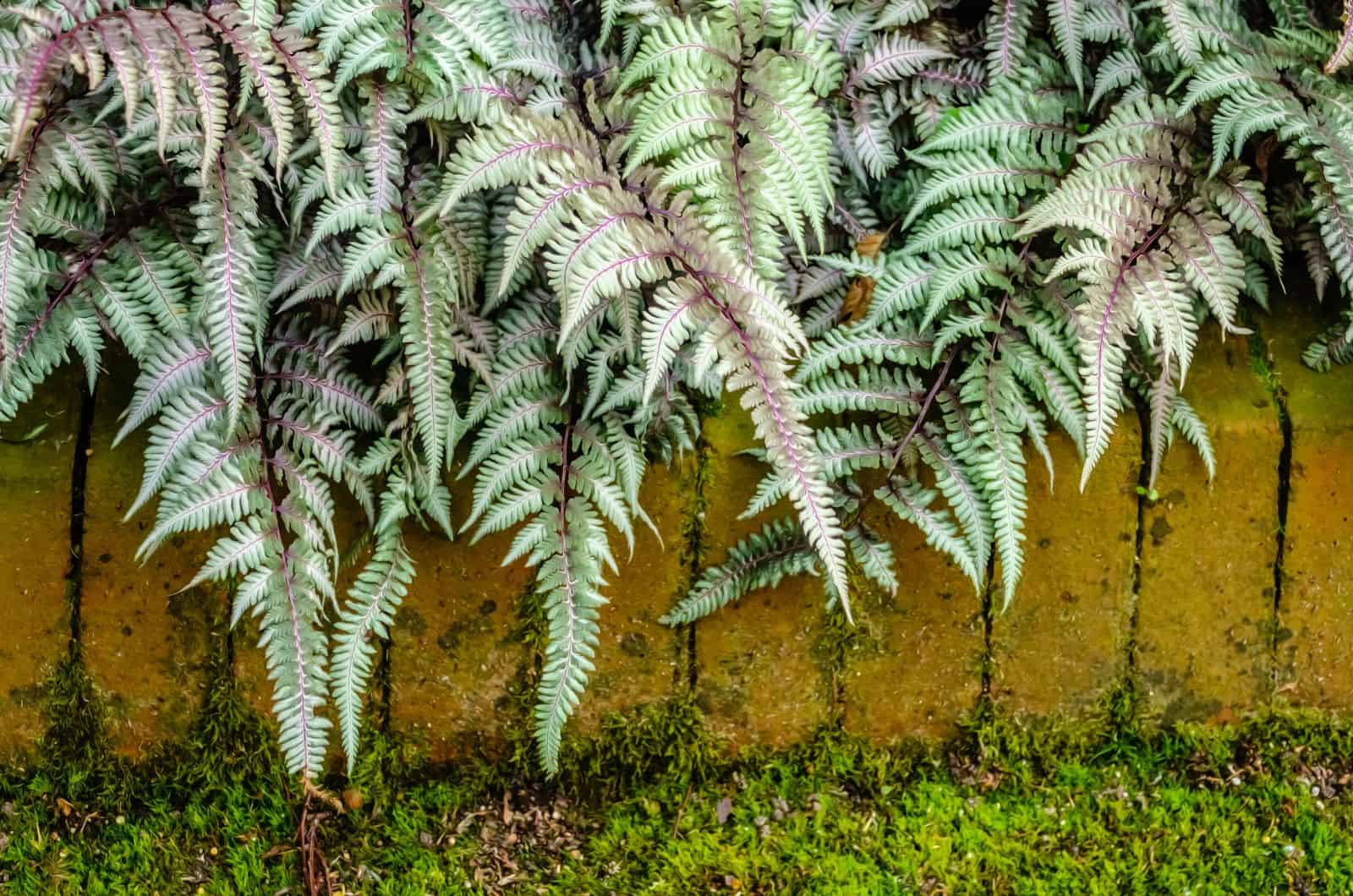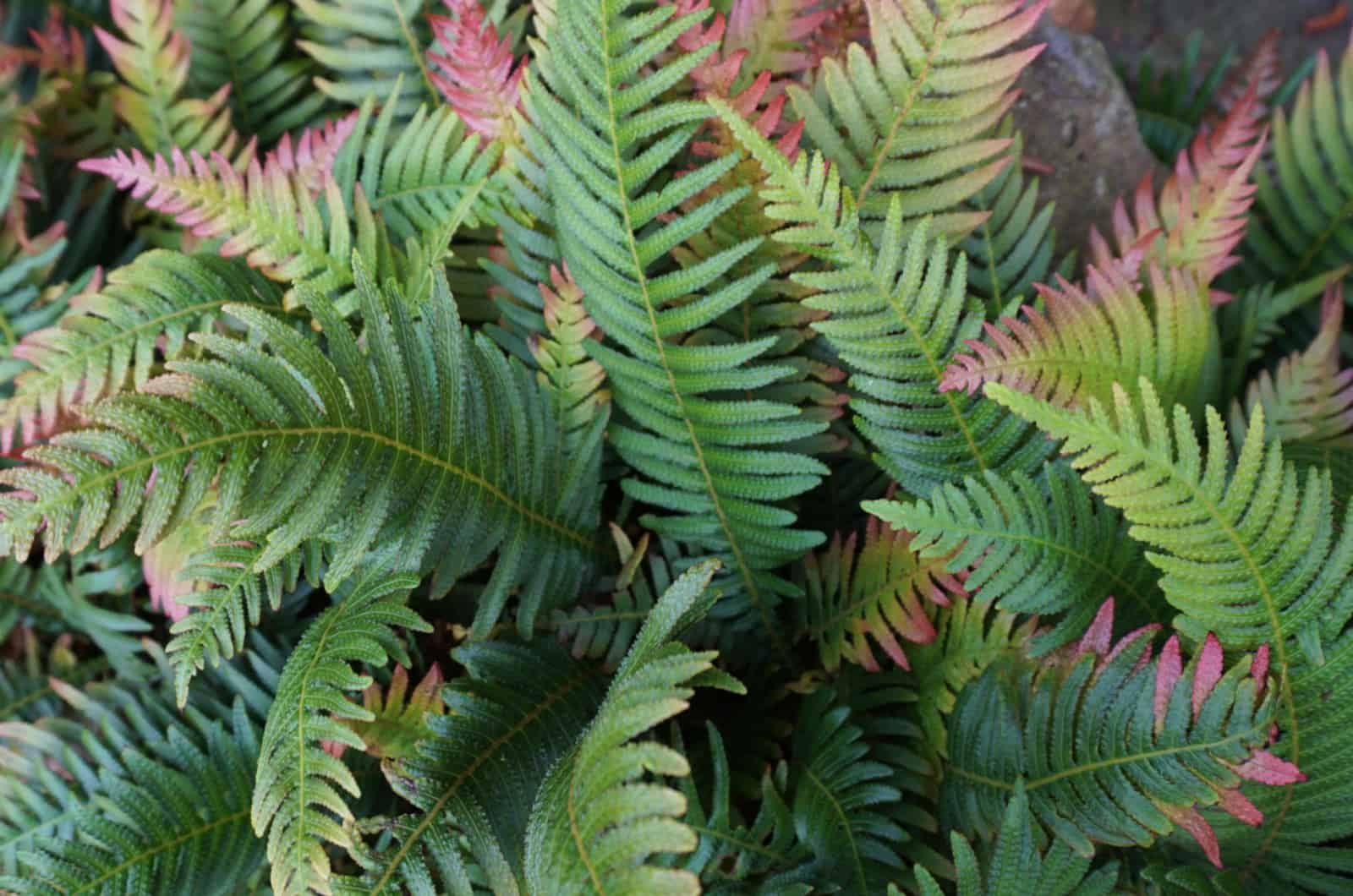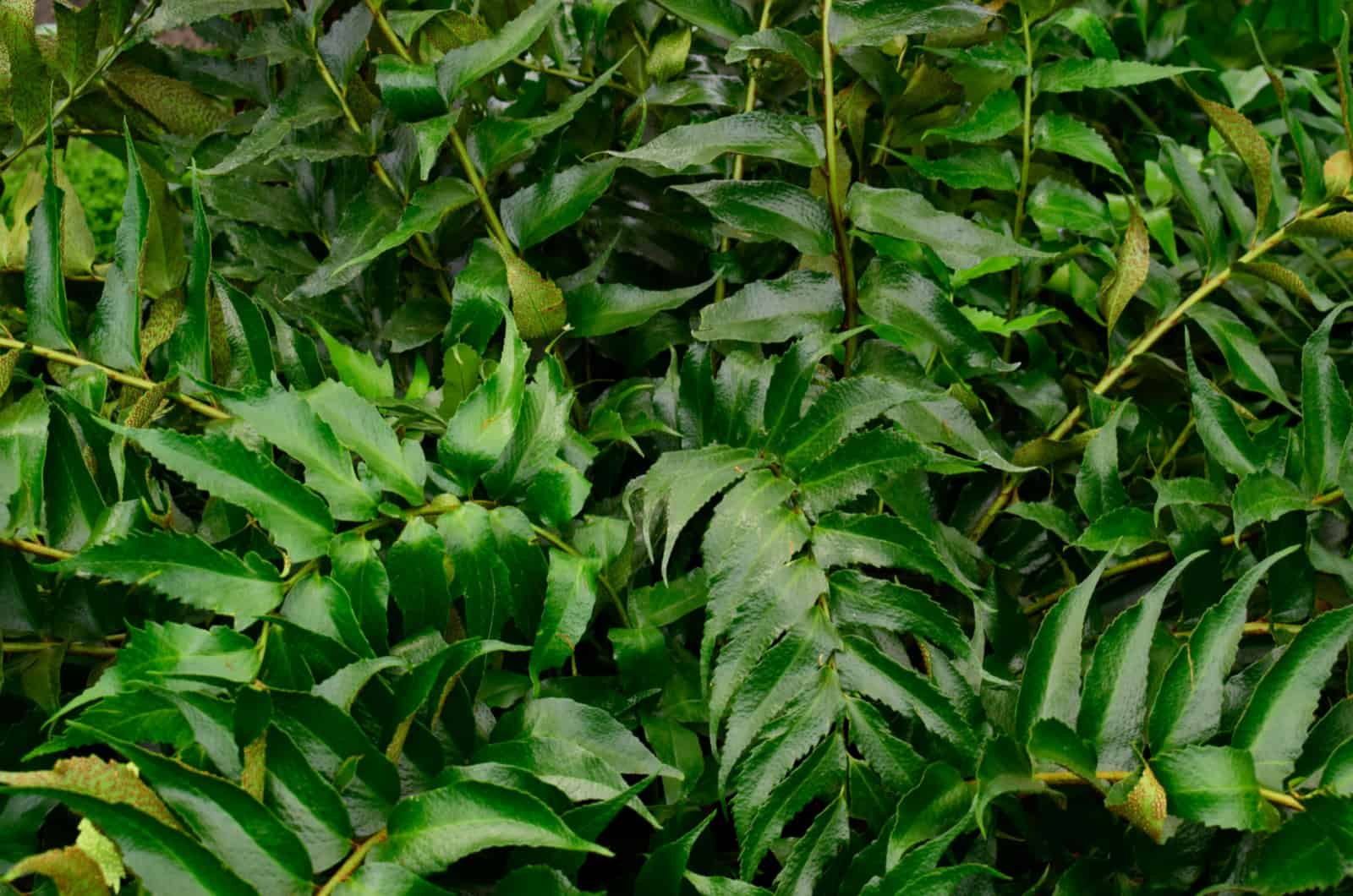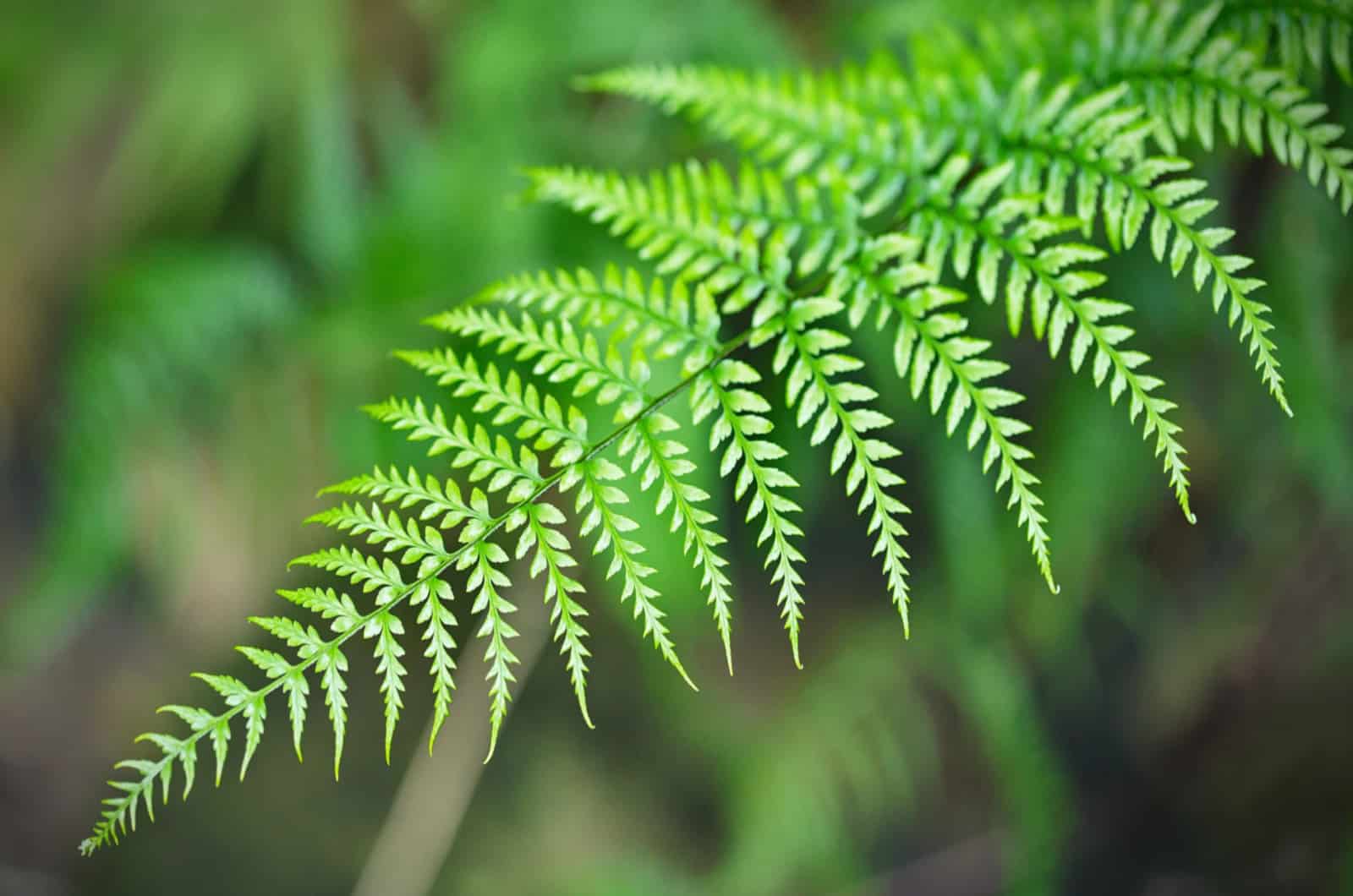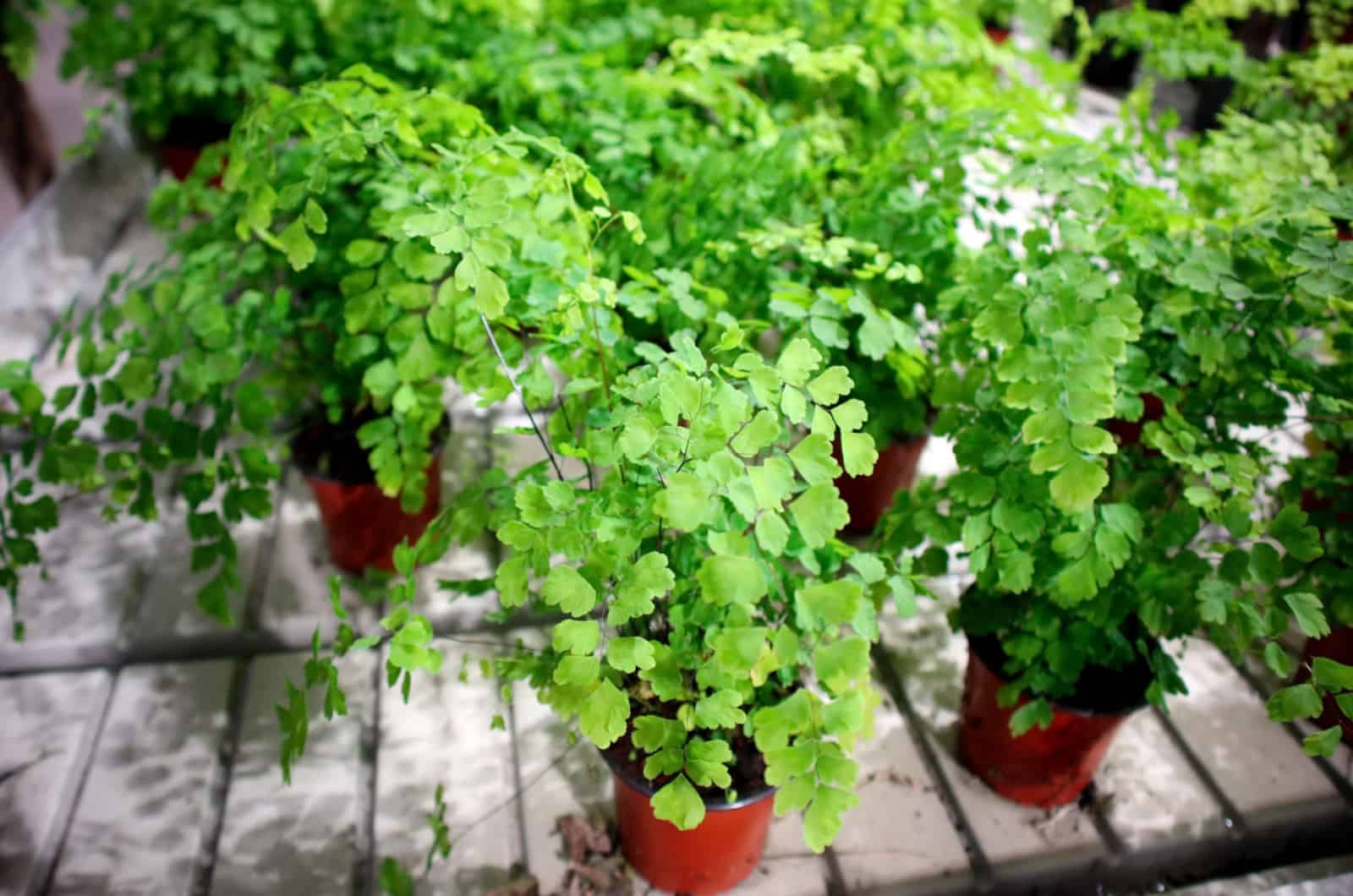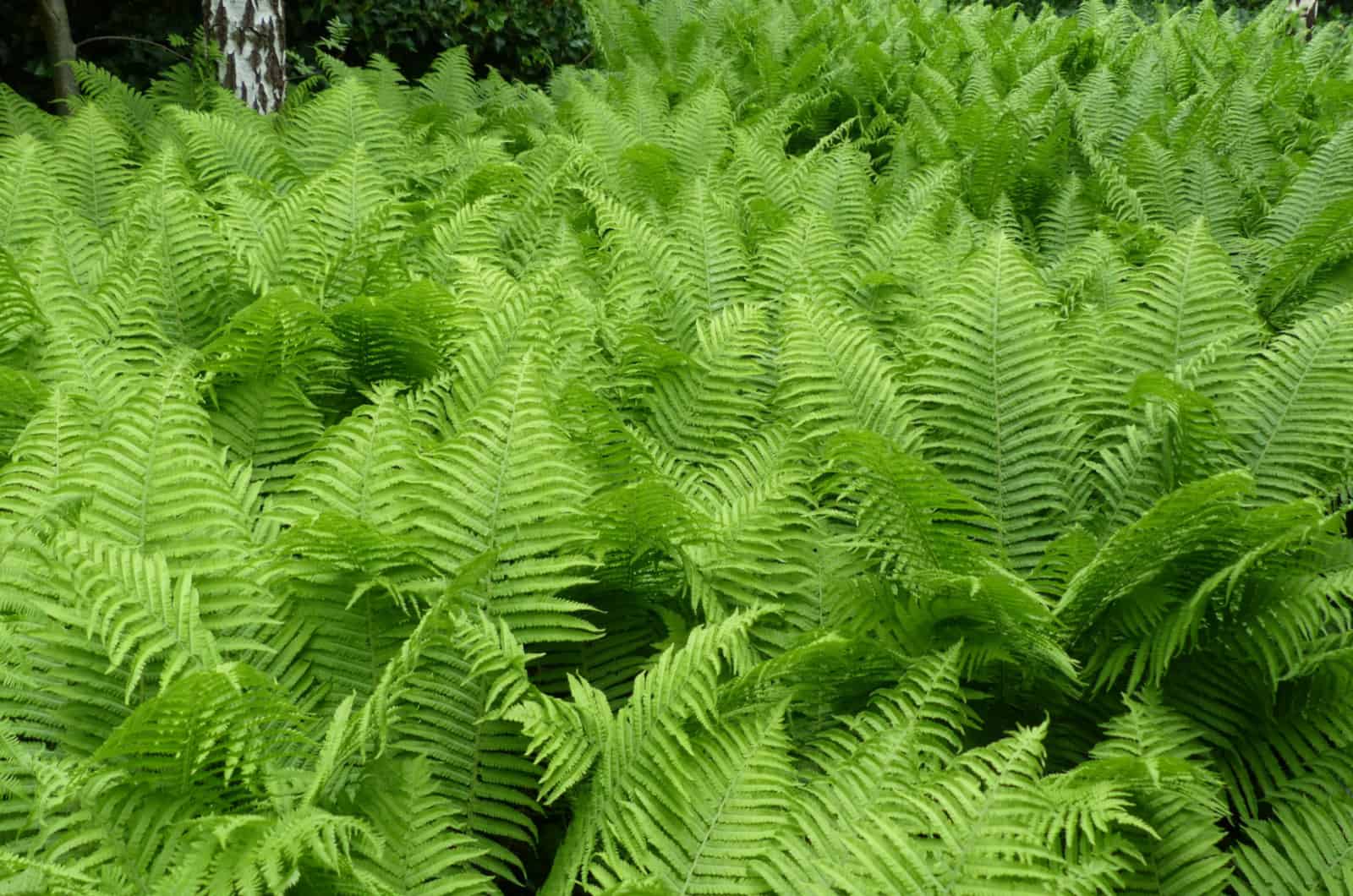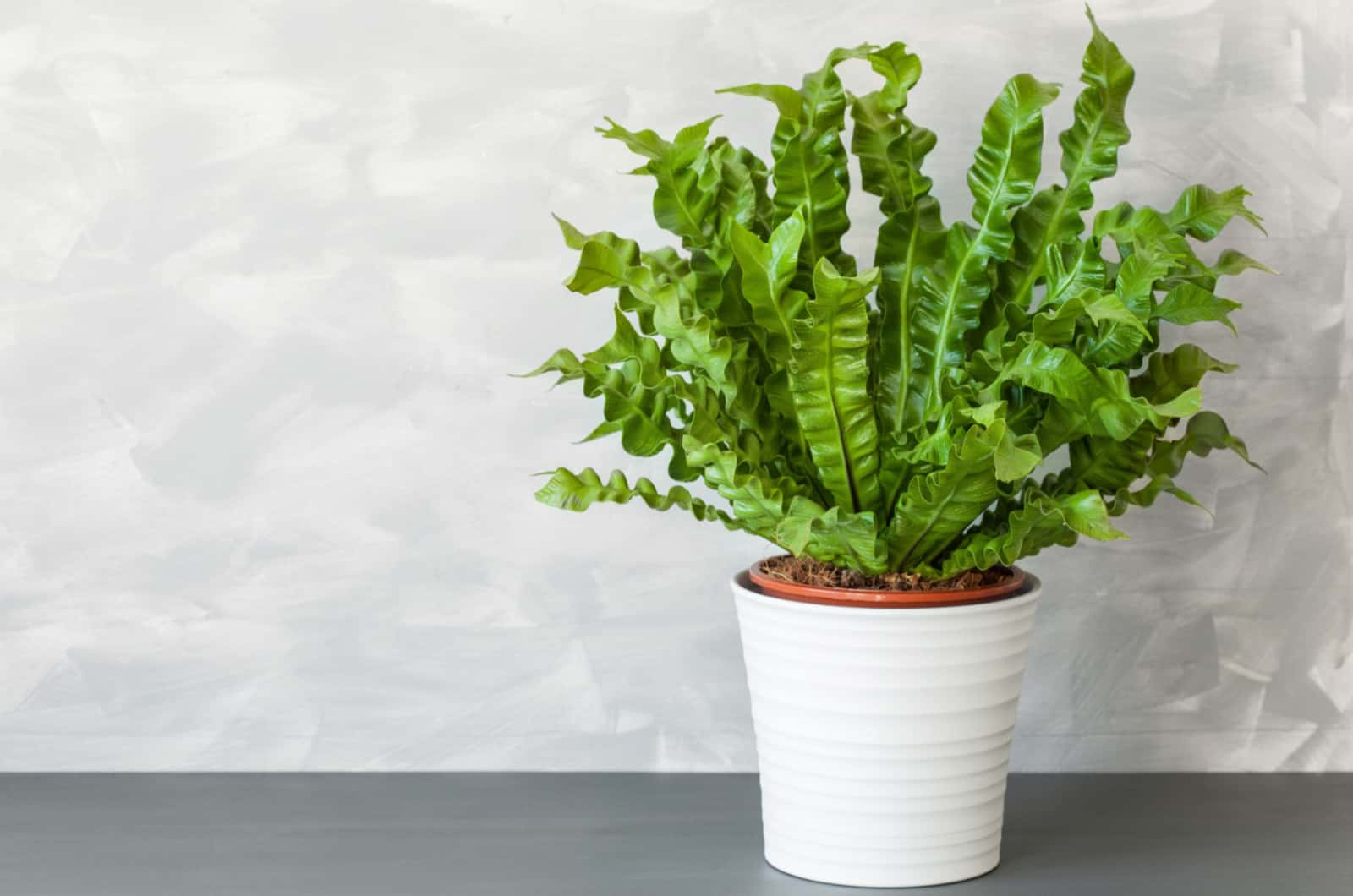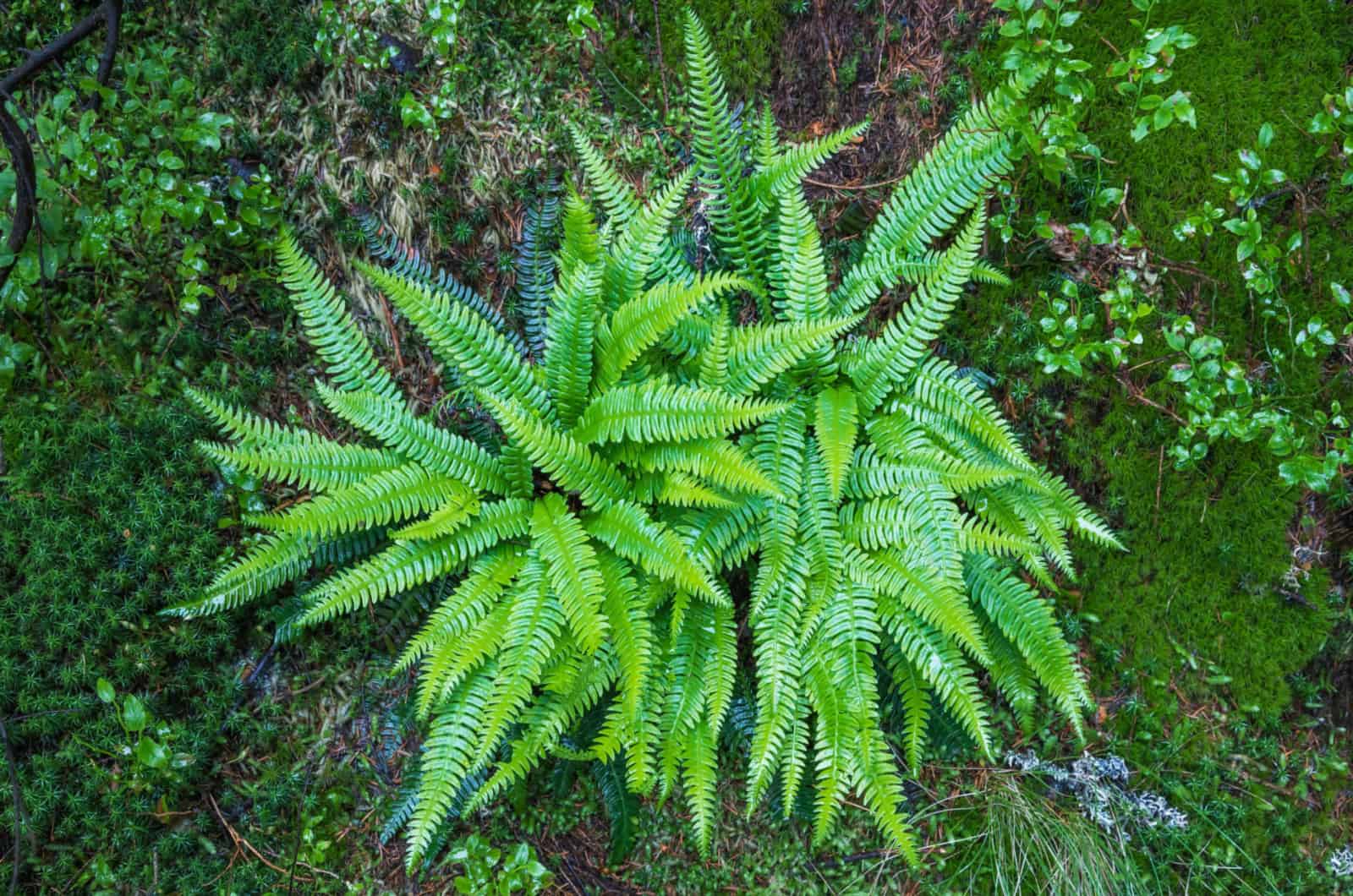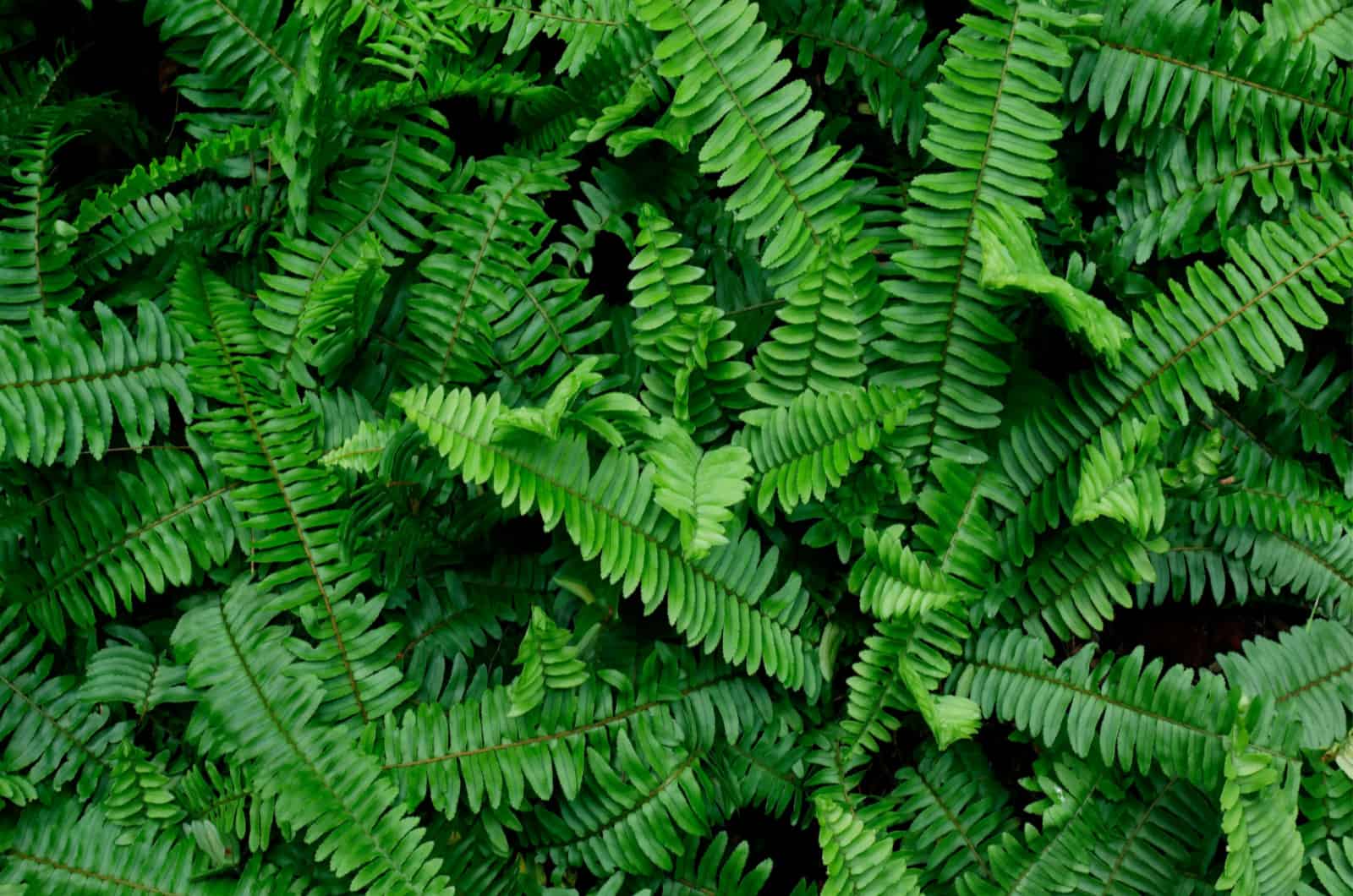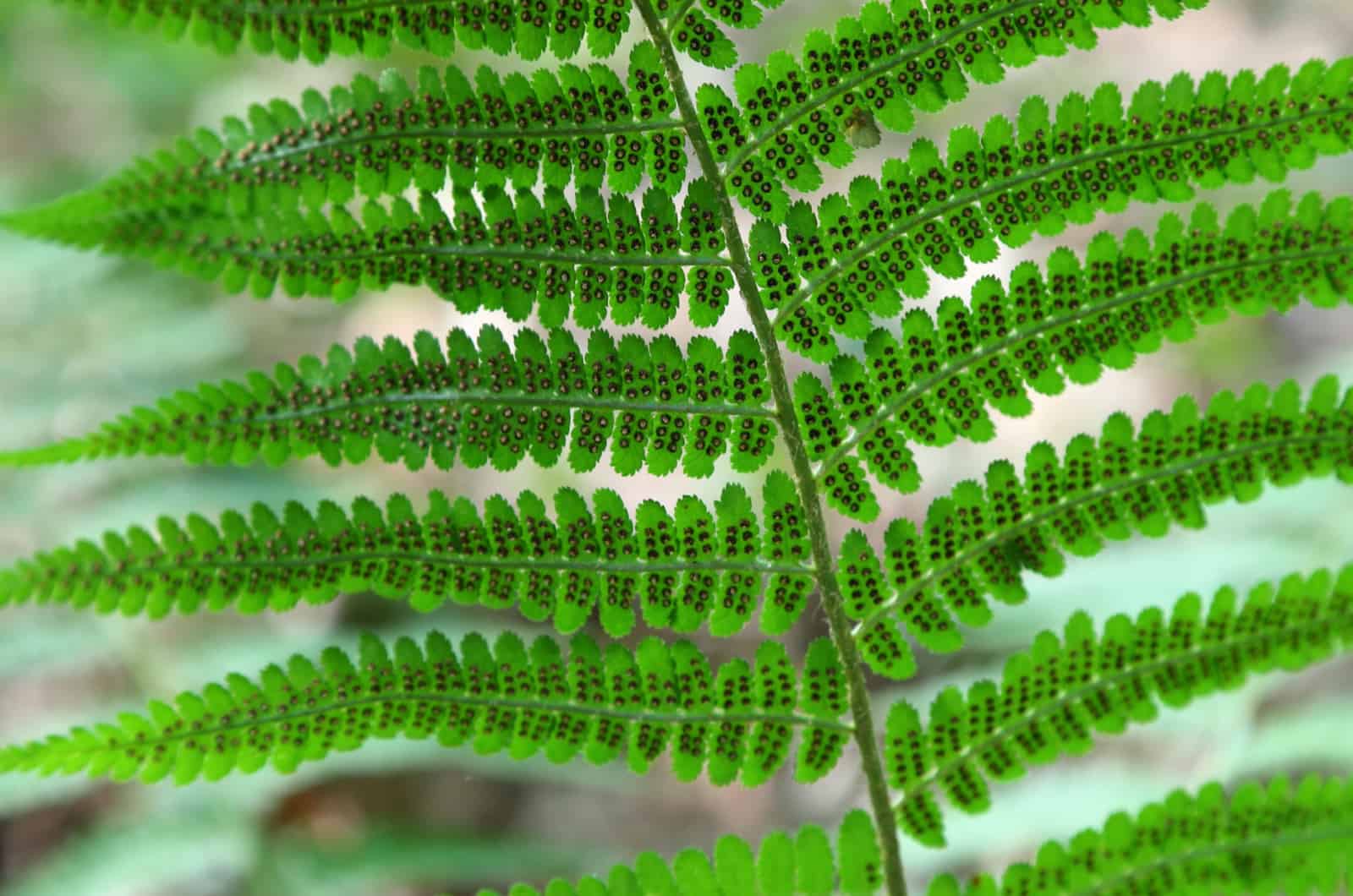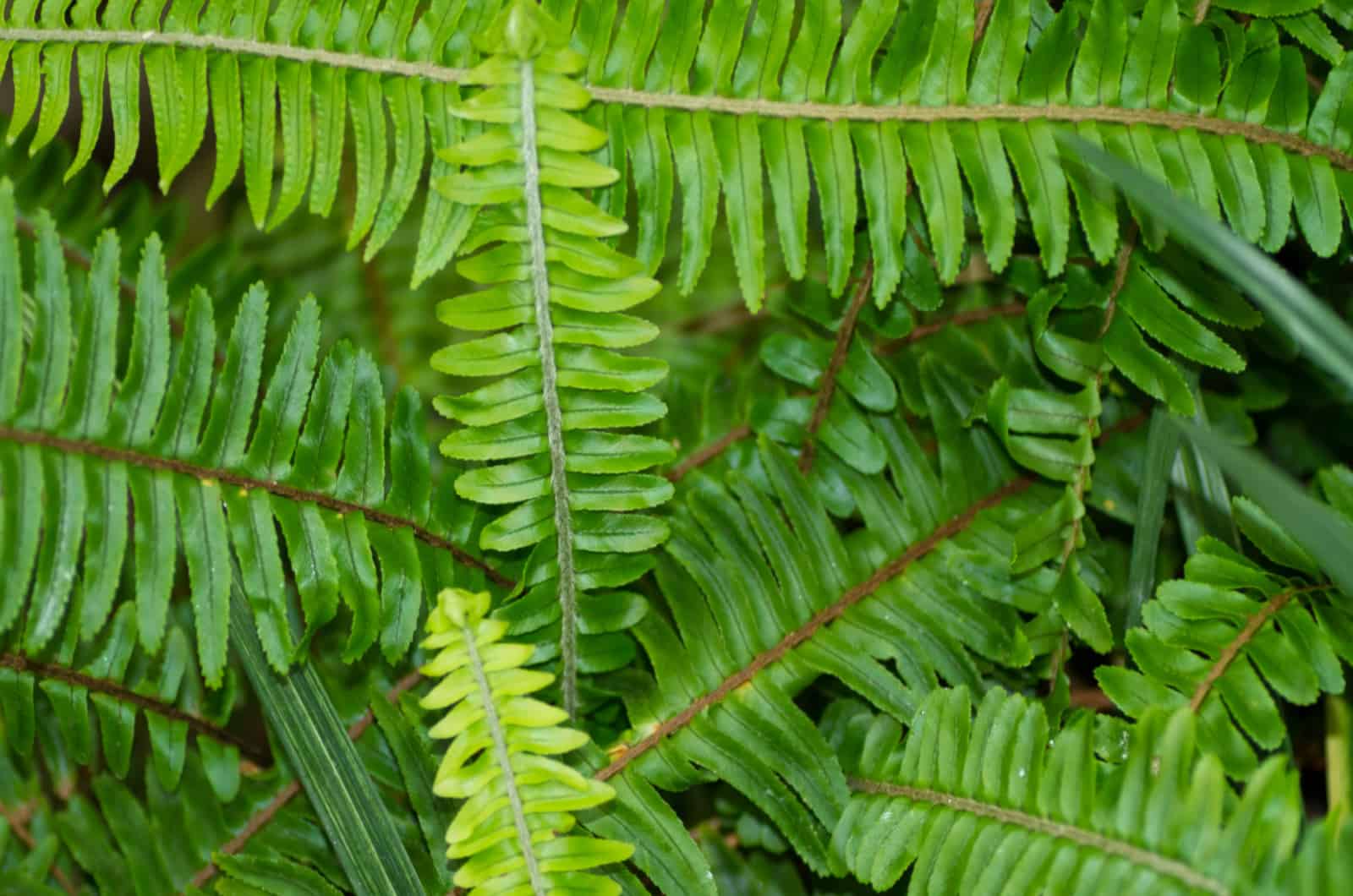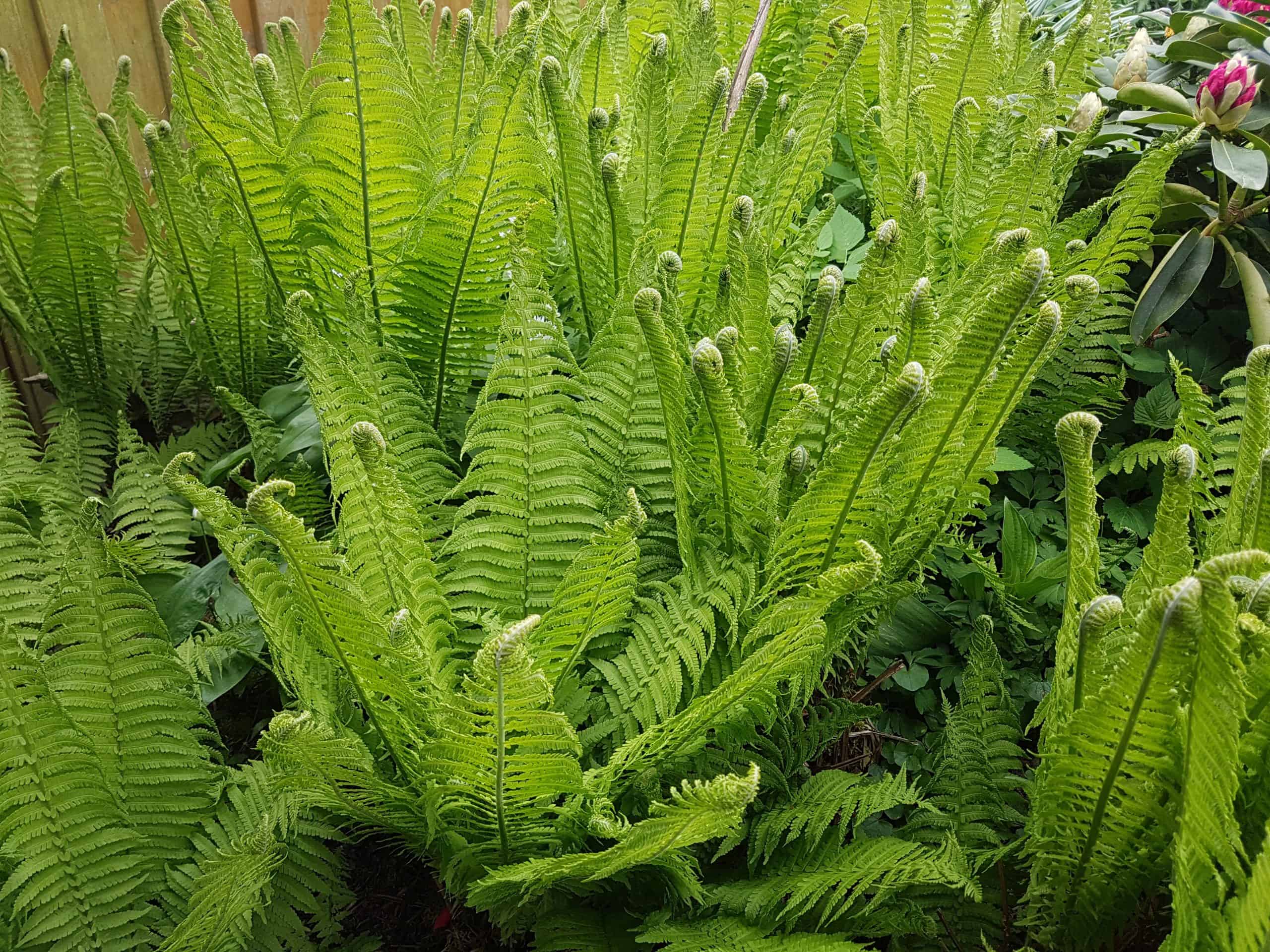Many gardens have shady areas, and we all know that evergreen plants need a lot of light to preserve their color.
Ferns are unique plants that make every garden or household look better, so it’s no wonder they are so popular nowadays. Ferns even look great in flower arrangements.
Today I want to show you some great evergreen ferns that’ll make your garden look fascinating because they stay green all year long!
I’ll also give you some care tips so your ferns stay healthy and happy for a long time!
Let’s get started!
A List Of Evergreen Ferns
Believe it or not, there are about 15,000 species of ferns worldwide.
The most common evergreen ferns are:
• Japanese painted fern
• Christmas fern
• Shield fern
• Holly fern
• Tassel fern
• Maidenhair fern
• Lady fern
• Bird’s nest fern
• Hard fern
• Western sword fern
• Male fern
• Royal fern
• Ostrich fern
Let’s look at them in more detail!
Japanese Painted Fern (Athyrium Niponicum)
I used to think that all ferns looked the same. They are similar in shape and color, but they are all called ferns for a reason!
Once I started growing plants, I was fascinated by ferns and looked for the one that differed the most. Then I found out about Japanese painted ferns, which are undoubtedly the most colorful ferns. Due to the silver color of their leaves, they have become a really trendy plant.
The leaves of these plants are often referred to as fronds, and mature Japanese painted ferns form an arching shape.
Their silver foliage is indeed intriguing, but what makes this fern even more beautiful is the pale green, almost gray, and purple-pink midribs.
Don’t expect it to reach its full size quickly; it’s a slow-growing plant that grows about 12 inches a year.
I recommend varieties such as Pictum and Burgundy lace.
Before we move on to a short care guide, here’s some basic info about the Japanese painted fern:
[table id=227 /]
Let’s see how to grow this fascinating plant!
How To Grow A Japanese Painted Fern
Many gardeners consider this plant to be either a partial or full-shade plant, but it’s actually the climate of your area that will decide the light level for you.
For example, if you live in the south you’ll need to grow this type of fern in full shade. On the other hand, if you live in the north, full shade works fine, but a spot with partial shade will allow your fern to preserve its color and grow healthy.
You’ll need to ensure it has soil with good drainage if you decide to grow this fern. That’s the only way to prevent the fungal infections that often lead to root rot.
Another essential aspect of Japanese painted fern plant care is a proper watering schedule. Your goal is to keep the soil moist, but be careful not to water too frequently because overly wet soil will attract the fungus mentioned above.
The ideal temperature range for this type of fern is between 55 and 80 degrees Fahrenheit. Additionally, ensure moderate to slightly higher humidity (40 to 60%).
You can skip fertilization if you amend the soil with organic matter. If you use commercial fertilizer, feed your fern in the early spring using a balanced fertilizer (please adhere to the label’s instructions!).
Christmas Fern (Polystichum Acrostichoides)
The Christmas fern has become a popular option due to its adaptable nature.
This fern features spreading rhizomes, which develop beautiful dark green fronds that grow in clumps.
The leathery leaves stay green all year long, even during Christmas, which makes this fern an excellent choice for many types of gardens.
It can reach 36 inches tall!
Here’s some basic info about the Christmas fern:
[table id=228 /]
Let’s find out how to grow this fern!
How To Grow A Christmas Fern
The Dagger fern will do best if grown in full shade. This is one of the rare fern types that can tolerate a little bit of direct sunlight.
However, I recommend staying on the safe side and ensuring at least partial shade. If you grow your dagger fern indoors (yes, you read that right), ensure it gets bright indirect light.
Luckily you won’t have to spend much of your precious time thinking about the perfect soil for your dagger fern. Add organic matter and well-draining materials such as perlite, and your fern will grow just fine.
Watering, on the other hand, is another matter entirely. Moist soil is the key to healthy growth, which means the Christmas fern requires frequent watering. Remember that the dagger fern isn’t drought-tolerant and may develop crispy and wilting leaves if it’s lacking water.
However, be sure that the soil isn’t too wet as that also causes issues like root rot and yellow leaves. Always check the moisture content in the soil before adding any water.
The great thing about this fern is that it’s cold tolerant, so it will be fine as long as the temperatures aren’t below -25 degrees Fahrenheit.
Ensure a humid environment and feed your Christmas fern during spring and summer with a 20 20 20 fertilizer diluted to half strength.
Japanese Shield Fern (Dryopteris Erythrosora)
The Japanese shield fern is often referred to as autumn fern due to the color of its foliage. In the spring, you’ll notice new growth of copper-red leaves.
This color really reminds me of fall, and as the season goes on the lustrous leaves’ hue gradually shifts to an equally vivid green.
This type of fern is perfect for smaller gardens as it doesn’t grow very wide. It makes a fantastic ground cover and also looks eye-catching when grown in pots.
If you are looking for a deer-resistant and low-maintenance plant, the Japanese shield fern is just what you need!
Before I show you how to grow this plant, here’s some basic info:
[table id=229 /]
Let’s look at the conditions required for your copper shield fern to thrive!
How To Grow An Autumn Fern
You must grow Japanese wood fern in a shade garden. Its health is negatively impacted by the direct sun, which can burn it to death!
Acidic soil (pH below 6.0) with plenty of organic matter and good drainage is ideal for this fern.
Your autumn fern will be fully established at the end of the first growing season, but until then it will need frequent watering. This primarily refers to the areas with infrequent rainfall.
This type of fern will grow well in warmer climates and climates with harsh winters. However, this fern struggles to grow in dry conditions.
If you live in hardiness zone 5, the fronds may wither, but don’t worry – they’ll get back on track in spring.
If you ensure fertile soil, fertilization isn’t mandatory, just add all-purpose fertilizer once in spring. This relates to outdoor ferns planted directly in the soil, if you grow wood fern in a pot you’ll need to feed it every month during the growing season.
Japanese Holly Fern (Cyrtomium Falcatum)
The pinnate fronds of the holly fern plant consist of dark green leaves that resemble the crescent moon.
These ferns make excellent borders and are perfect for rock gardens. The fishtail fern is deciduous in colder regions, but an evergreen fern in hardiness zones 6-10.
It’s a slow-growing plant that can grow up to 3 feet, but it’ll take about 5 years to reach that size.
This type of fern is perfect for a Zen garden on a budget.
Before I show you how to keep your holly fern happy and healthy, here’s some basic info:
[table id=230 /]
Let’s look at the perfect conditions for this type of fern!
How To Grow A Holly Fern
Holly fern will do best in part shade. It’s essential to keep this fern away from direct sunlight unless you want to see the demise of its green foliage!
This is a very adaptable fern when it comes to soil conditions. It will grow well in all pH ranges, and the only requirement for the soil is that it’s well-draining.
You can use compost based on loam or sandy soil. Adding perlite, pumice, vermiculite, or bark is also a great idea.
Just like all other fern types, holly fern prefers moist but not waterlogged soil. When watering, give your holly fern a good soak and then wait until the soil dries 2-3 inches to water again.
You can use an all-purpose fertilizer to boost growth and plant holly ferns next to hostas beause they make great companion plants.
Tassel Fern (Polystichum Polyblepharum)
If you want to add elegance to your woodland garden, I recommend planting a tassel fern! This fascinating semi-evergreen features dark green fronds that form an arching shape.
When you group a lot of tassel ferns, they make excellent ground covers. Many gardeners claim that this is one of the best ferns to grow, which is why it has been awarded by the Royal Horticultural Society!
You’ll often see this type of fern in flower arrangements.
It can grow up to three feet tall and wide.
[table id=231 /]
Let’s find out how to grow Polystichum polyblepharum!
How To Grow A Tassel Fern
This is another shade-loving plant, so it’s perfect for dark areas of your backyard. It also grows well in partial shade as bright indirect light helps the leaves preserve their green color.
The soil has to drain well for the healthy growth of this fern. There are many soil types (sandy or loamy) and pH levels (neutral, alkaline, or acidic) that will satisfy the needs of the tassel fern plant.
When grown in full shade, plants don’t require much water because the sunlight helps the soil drain better but also scorches the leaves. Therefore, keep your tassel fern soil moist but not overly wet.
This fern isn’t prone to pests and diseases, but botrytis may occur if the humidity is too high. If you are concerned with deer and rabbits, don’t worry, they don’t find tassel fern attractive like humans do!
If the soil you’re using is humus-rich and fertile, then additional fertilizer isn’t required.
You can get more tassel ferns by propagating the spores.
Maidenhair Fern (Adiantum Raddianum)
I usually refer to the maidenhair fern as the ‘drama queen’ of ferns. It’s the most demanding fern on this list when it comes to maintenance.
This fern got such an interesting name because the fronds look like they are swaying and are reminiscent of hair. The fronds are pretty tiny, and they grow in the shape of a fan.
If you visit tropical parts of South Africa, you’ll see this fern growing near waterfalls on rocks. Due to their natural habitat, these ferns require high humidity levels, which makes them difficult to grow.
Here’s some basic info about the maidenhair fern plant:
[table id=232 /]
Let’s see how to grow this fussy plant!
How To Grow A Maidenhair Fern
The tricky thing about this fern is that it likes a lot of light. However, they quickly burn if the sun’s rays touch their beautiful fronds.
So, you’ll need to find a spot where this fern can get plenty of bright indirect light and is protected from the direct sun. This fern doesn’t grow well in low light, so if you notice discolored new fronds and stunted growth, your maidenhair fern needs more light.
The soil should drain well, so add draining materials (perlite or pumice). But keep the soil constantly moist! The easiest way to achieve this is by adding materials such as peat moss to aid in water retention.
If you want to keep this fern healthy, you’ll need to check the soil every day (yes, it’s that demanding). You’ll most likely need to water this fern every day.
I recommend growing this type of fern in pots as it’s easier to control the conditions. When choosing a pot for this fern, make sure it’s made of plastic and has drainage holes. Plastics don’t let the soil drain quickly and drainage holes prevent the excess water from pooling around the roots.
I know that plastic pots aren’t as attractive as cache pots, but you can always put the plastic one into the cache pot.
This fern requires high humidity – if you have a greenhouse you should place it there, and if you grow this fern indoors you can put it in a bathroom or kitchen.
Lady Fern (Athyrium Filix-Femina)
Lady fern is a plant you should get if there are areas in your garden where nothing grows well. Whereas many plants struggle in shady areas, these graceful, native ferns do very well in them.
This Athyrium fern will stand out thanks to its elegant, beautiful, and silky fronds. The summertime green fronds of this plant change to a golden-yellow color following the first cold.
Green, purple, or red fronds support small leaves that give this unique fern a lacy appearance.
This is another type of fern frequently used in flower arrangements. The lady fern is also used in many healthy recipes due to its nutritional value.
Here’s some basic info about this breathtaking plant:
[table id=233 /]
Let’s find out how to keep lady fern happy and healthy!
How To Grow A Lady Fern
These ferns will thrive in shady areas of your garden. Be careful with the direct sun – it’s better to put it in part shade than in direct light.
These ferns grow in the fertile and well-draining soils of North America, so it would be best if you could mimic those conditions. Adding compost to the soil before planting your lady fern is the best way to ensure it has enough nutrients.
Like other ferns, the lady fern prefers frequent waterings and saturated soil. If it lacks water, this plant will wilt and the fronds will most likely turn brown.
Don’t worry, if you stick to the proper watering schedule your lady fern will get back on track next spring. This fern is very sensitive in the first growing season. Still, once it’s established it becomes pretty resistant to many issues.
If you live in hardiness zones 7-9, I recommend growing the Southern lady fern species as they do better in higher temperatures than the lady fern.
The best food for this type of fern is compost or organic matter like shredded leaves. If you are using commercial fertilizer, I recommend slow-release fertilizers as these plants are quite susceptible to fertilizer burns.
Bird’s Nest Fern (Asplenium Nidus)
This type of fern is an epiphytic perennial, which means that it grows on other plants in its native habitat. The light green fronds develop from a rosette and can reach 5 feet outdoors and about 2 feet indoors.
I recommend planting this fern in the spring. The best varieties are Osaka, Victoria, and Crispy Wave.
[table id=234 /]
Let’s see how to grow a nest fern!
How To Grow A Bird’s Nest Fern
Outdoors, the bird’s nest fern grows best in partial shade. You should ensure bright indirect light if you grow this fern indoors.
Although these ferns benefit from the direct morning sun, avoid the intense midday sun. They prefer loose, fertile soil with good drainage. Plants in containers do well in potting soil that contains peat.
Keep your bird’s nest fern soil constantly moist, but avoid water pooling. Never water the fronds as they are very sensitive – only water the soil when the top inch dries.
Make sure the temperatures are higher (60 to 80 degrees Fahrenheit) as this isn’t a very hardy fern.
You can feed your bird’s nest fern once a month during the growing season with liquid fertilizer. Always follow the label’s instructions and dilute to half strength.
Hard Fern (Blechnum Spicant)
The Blechnum spicant, also known as hard fern or deer fern, is very trendy these days. It features slender, dark green fronds.
A special thing about this fern is that it features two types of fronds: evergreen sterile fronds and fertile fronds.
Once the fall arrives the fertile fronds turn brown and fall off, and you notice the evergreen fronds.
It can reach 1.5 feet in height and about 2 feet in width.
Here’s some basic info about hard ferns:
[table id=235 /]
Let’s find out how to grow deer fern!
How To Grow A Hard Fern
This is another type of fern perfect for shady areas – either part or full shade.
You’ll need to ensure moist but well-draining soil, though this fern also grows well in poorly draining soils. However, I recommend staying on the safe side and adding clay or loam to the soil.
Don’t let hard fern soil dry out between waterings or you’ll stress the plant. When you notice that the top few inches are dry, water the soil thoroughly.
This fern doesn’t require additional food if you add compost to the soil before planting.
Western Sword Fern (Polystichum Munitum)
I’m sure you’ve heard of western sword fern, even if you are a beginner grower. It’s native to the Pacific Northwest and is popular, super easy to grow, and thrives both outdoors and indoors.
It features light green sword-like fronds that can reach up to 4 feet in length.
Here’s some basic info about this Polystichum plant:
[table id=236 /]
Let’s look at the perfect conditions for this type of fern!
How To Grow A Western Sword Fern
Find a shady spot in your garden. If it receives only a small amount of sunlight, your western sword fern can withstand it.
These evergreen ferns prefer acidic soil, so planting them under pine trees is a great idea.
If the soil is well-draining, you will most likely need to water it once a week. Make sure the soil is never soggy as these ferns are prone to root rot.
These ferns aren’t drought-tolerant, so make sure the soil moisture content is always high.
I recommend adding 20 20 20 fertilizer a few times during spring and summer (dilute the 20 20 20 to half strength).
Male Fern (Dryopteris Filix-Mas)
Earlier I introduced you to the lady fern, and now I want you to meet its male counterpart – male fern. It’s called male fern as it’s stronger and grows taller and wider than the lady fern.
An unattractive feature of this fern is that it’s toxic! Its nickname is dead man’s fist, which doesn’t sound great either.
The leaves of male ferns grow in clusters and have brown spore sacs on the leaf undersides. This is a beautiful fern, which is why it’s grown in gardens.
Here’s some basic info about the masculine version of lady fern – male fern:
[table id=237 /]
Let’s see how to grow this temperamental plant!
How To Grow A Male Fern
The male fern thrives in partial shade but can withstand shorter periods of full sun exposure.
The soil needs to have adequate drainage, so I recommend adding sand or chalk. All pH ranges suit this type of fern.
Although the male fern thrives in moist soil, it’s also drought-tolerant.
If you grow roses or shrubs, this type of fern serves great if underplanted.
Royal Fern (Osmunda Regalis)
If you want to add a dose of royalty to your garden, the elegant royal fern is just what you need.
It grows in clumps and can reach 6 feet tall. It produces pinkish flowers and has fascinating leaves that are reddish-brown in the fall.
Here’s some basic info about royal fern:
[table id=239 /]
Let’s take a look at how you can grow this unique flowering fern!
How To Grow ARoyal Fern
Once you find the perfect location for this fern, it becomes quite a low-maintenance plant.
Find a shady and moist area in your garden, and if it receives a little bit of morning sunshine don’t worry because it won’t harm your royal fern.
The soil also needs to be acidic and drain well, so add compost and bark or pine needles to aid drainage and increase acidity.
You can trim off the fronds that turn brown in the fall.
If you have some water features in your garden, you can plant your royal fern close to them.
Ostrich Fern (Matteuccia Struthiopteris)
You can find ostrich ferns in many restaurants during the spring. It’s edible, and not only used in cooking but also grown as an ornamental plant.
This is a slow-growing fern that reproduces via spores.
Here’s some basic info about the ostrich fern:
[table id=238 /]
Here’s how to grow a fiddlehead fern.
How To Grow An Ostrich Fern
If you ensure fertile and constantly moist soil, this type of fern will grow well in part shade to full sun.
It requires slightly acidic soil, so I recommend adding compost prior to planting. You’ll also need to ensure it gets about two inches of water each week.
If you live in arid climates, you can add mulch to the soil and water more frequently to maintain a constant moisture level for the roots and soil. If there isn’t sufficient moisture, the leaves will most likely scorch.
Temperatures between 65 and 80 degrees Fahrenheit are perfect for an ostrich fern, though it can tolerate temperatures as low as -4 degrees Fahrenheit.
It also thrives in high humidity (over 50%), and you can skip fertilization if you ensure it has humus-rich soil.
Wrapping Up
No one wants a bare spot in their garden with no plants.
These are primarily shaded areas, and most plants require either full sun or bright indirect sunlight.
Now you know some evergreen ferns that will make your garden look remarkable, including the shady areas!
Choose the one you like best, and when it matures use some in flower arrangements to gift to your loved ones!
Until next time!
Like this post? Share or pin it for later!

